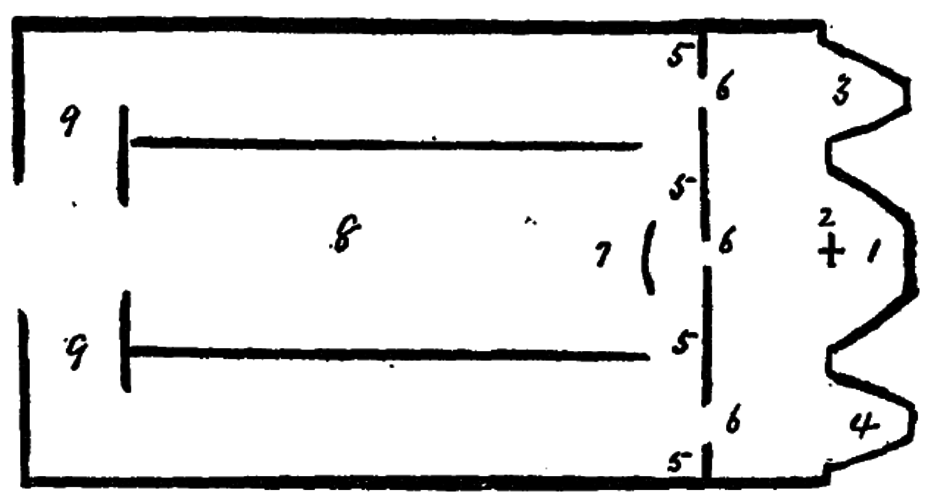Contents
| « Prev | Church Architecture | Next » |
IV
The following is a typical plan, roughly drawn, of a Greek church.

1. The Bema; 2. The Altar; 3. The Prothesis; 4. The Diaconicon; 5. The Iconostasis; 6. Doors; 7. The Ambon; 8. The Nave; 9. The Narthex.
From this plan it will be seen at a glance that a Greek Church consists of four parts: (1) The Bema or Sanctuary, which 50 contains the altar, and on either side the Prothesis and the Diaconicon. From the choir the Sanctuary is separated by the Iconostasis, which answers to the altar rails in a Roman Church. (2) In front of the Iconostasis is the Choir, not architecturally separated from the Nave, but occupying the eastern end of it. (3) The Nave. (4) The Narthex. In some of the larger churches there are two Nartheces--the esonarthex and the exonarthex, the latter serving the purpose of an extended porch.
To look at the arrangement and detail of the church more particularly--
The (ἅγιον βῆμα) Bema or Sanctuary, for the due celebration of the Holy Mysteries, occupies the eastern end of the church. Only priests are allowed to enter the Bema, and by them it can be entered only after fasting and prayer. The altar which stands in the Bema is built of stone, Christ being the Head of the Corner, and the Foundation Stone, and is furnished with candles, a copy of the Scriptures, and the Cross.
The Prothesis, to the north of the Bema, is a small chapel, on the table of which the 51 sacred offerings are prepared for the altar. The chapel of the Prothesis is separated from the Bema by a wall to which entrance is had by a screened doorway.
The Diaconicon is to the south of the Bema, and contains the sacred utensils and vestments. It is of inferior sanctity, but the clergy of the lower orders are not allowed to enter it.
The Iconostasis is the screen which separates the sanctuary from the choir, and is so called for the reason that certain icons or pictures are depicted on it. It is of panelled wood, sufficiently high to hide the interior of the sanctuary from the worshippers. In some cases it is simply a curtain of some cloth fabric. It has three doors leading to the Prothesis, to the Bema, and to the Diaconicon. On either side of the door giving entrance to the Bema are the icons of our Lord and of the Virgin Mother--the one to the right and the other to the left. Other icons are displayed over the screen, which in many cases is quite a work of art.
In front of the Iconostasis is the choir, and opposite the Holy door leading to the 52 Bema is the Ambon, from which the reader recites the scriptures, and from which, on special occasions, sermons are delivered.
The Nave is that part of the church designed for the accommodation of the male portion of the congregation.
The Narthex gives accommodation to catechumens and penitents, where the Gospels can be heard, but from which the celebration of the Mysteries cannot be witnessed. Late comers usually content themselves with a place in the Narthex in order not to disturb the service. The Narthex is in some cases vaulted, as are also the aisles, so called, over which are galleries for the accommodation of the female portion of the congregation; where these are awanting, women are accommodated in the Narthex, as the division of the sexes during worship is rigidly maintained.
There are no seats in a Greek Church, as the recognised posture during worship is standing. In some churches narrow stalls are built in which the worshipper can stand, leaning forward, and resting his elbows during the long service; and in a church 53 which the writer visited some years ago in Constantinople, there were in those stalls narrow ledges upon which the knee can be rested. Organs are not used in the services; but as the greater part of the service is chanted by the singers, vocal music in some cases is carried to great perfection.
| « Prev | Church Architecture | Next » |